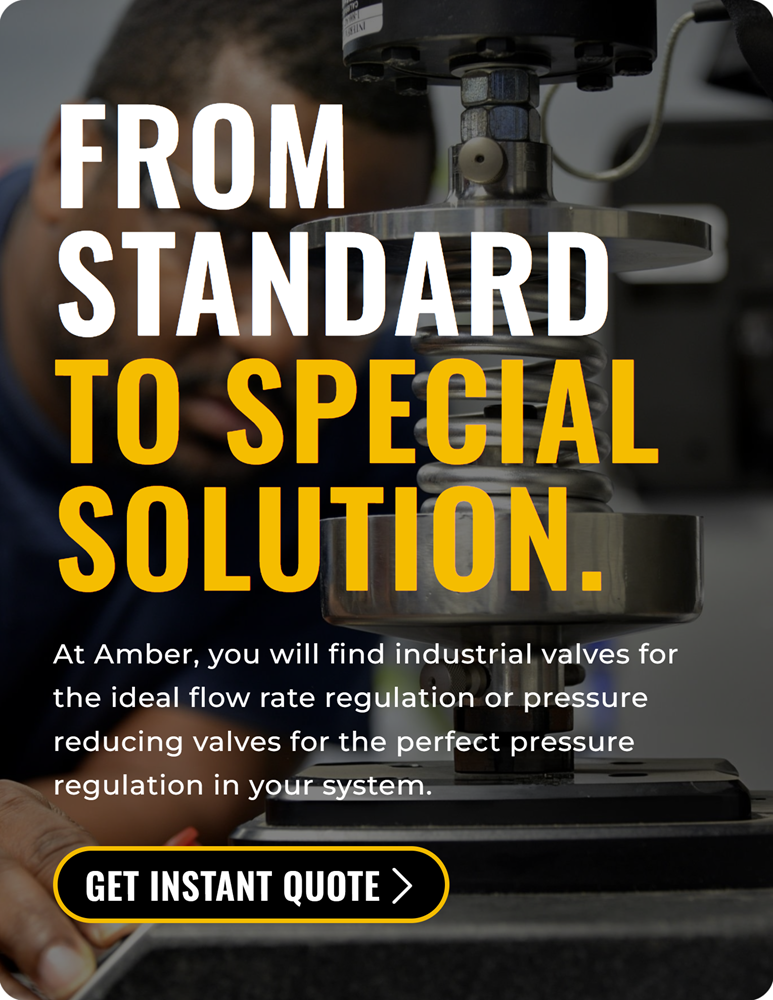Choosing the right valve can significantly impact the efficiency and safety of your fluid control systems. With numerous options available, many people find themselves struggling to understand the differences between various valve types, particularly ball valves and check valves. Are ball valve and check valve the same? What are the differences between them?
In this article, we will explore the definitions, functionality, working principles, materials, applications, types, control methods between ball valves and check valves. Additionally, we will provide practical tips on how to choose the right valve for your specific needs, including insights into ball check valves.
What are Ball Valves?
Ball valves are a type of valve used to control fluid flow in a pipeline. They consist of a spherical disc, or ball, with a hole through its center, which rotates within the valve body to either allow or block flow. When the valve handle is turned a quarter turn, the hole aligns with the flow direction, fully opening the valve. Conversely, turning it back closes the valve by positioning the ball perpendicular to the flow, effectively stopping it. Ball valves are known for their durability and reliability, making them suitable for high-pressure and high-temperature applications in industries such as oil and gas, water treatment, and chemical processing.
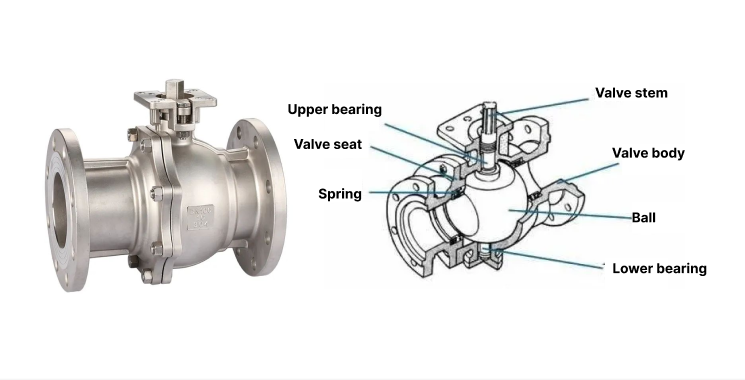
What are Check Valves?
Check valves are designed to prevent backflow in a piping system by allowing fluid to flow in only one direction. They automatically open when the fluid flows in the desired direction and close to stop any reverse flow, which protects pumps and other equipment from damage. The closing mechanism can rely on the weight of the valve disc, back pressure, or spring force, ensuring that the valve closes promptly in the event of backflow. Check valves are commonly used in applications such as wastewater treatment, sump pumps, and various industrial processes to maintain proper flow direction and system integrity.
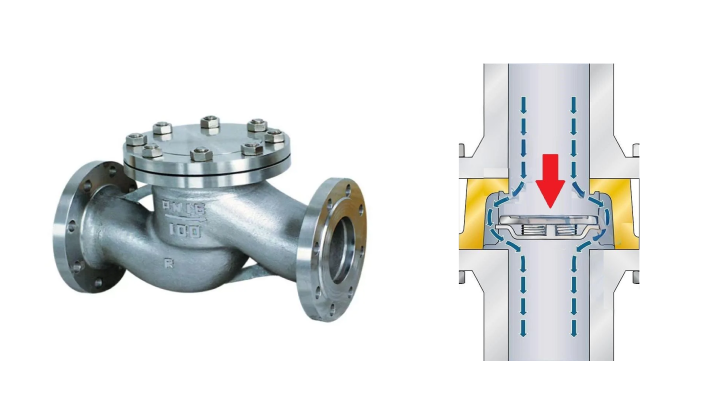
Difference Between Ball Valve and Check Valve
The following sections will explore their functionality, working principles, materials, applications, types, control methods, and the media they handle, helping you make informed decisions when selecting the right valve for your system.
Function
Function of Ball Valves
A ball valve is a type of valve used to control fluid flow, featuring a valve body that houses a spherical disc. This design allows the ball to rotate and achieve an open position, enabling or blocking the flow of fluid. Ball valves can completely open or close the flow, making them ideal for applications requiring precise flow control. For instance, in a water supply system, a quarter turn valve can be quickly operated to shut off the water flow to a specific area during maintenance.
Function of Check Valves
A check valve is designed to prevent backflow, allowing fluid to flow in only one direction. It automatically closes to stop inverse flow, which is crucial in protecting pumps and other equipment from damage. For instance, in wastewater treatment systems, check valves effectively prevent wastewater from flowing back into treatment facilities, safeguarding the normal operation of pumps and ensuring pump capacity is not compromised.
Working Principle
Working Principle of Ball Valves
The closing component of a ball valve is a spherical ball with a through hole. The actuator unlocks the valve by rotating it a quarter turn. When rotated, the ball’s hole aligns with the flow direction, allowing fluid to pass through; when closed, the ball rotates to position the hole perpendicular to the flow direction, blocking the media. Some designs utilize a segmented ball, which only uses part of the ball to block the flow.
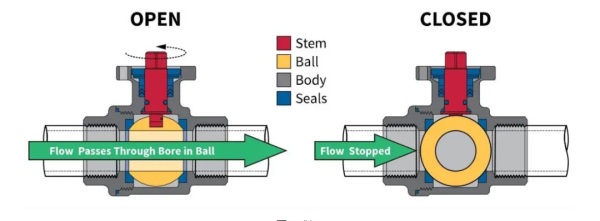
Working Principle of Check Valve
A check valve automatically opens in the desired direction of fluid flow and closes upon backflow. Its backflow prevention mechanism can rely on the weight of the valve disc, back pressure, or spring force. Spring-loaded designs can provide a positive seal, ensuring no fluid escapes in the closed position. The design of check valves ensures they do not obstruct forward flow while effectively preventing backflow. The cracking pressure of the valve plays a role in determining how much pressure is needed to open the valve under vertical flow conditions.
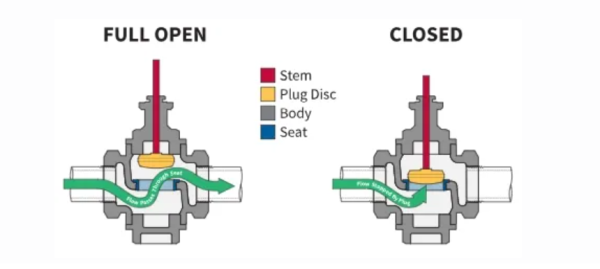
Materials
Materials of Ball Valves
Ball valves can be manufactured from various materials, including stainless steel, brass, and plastics. The choice of material depends on the required corrosion resistance, temperature, and pressure drop considerations. For example, stainless steel ball valves are suitable for high-temperature and high-pressure industrial applications.
Materials of Check Valves
Check valves are typically made from metals (such as cast iron and stainless steel) or plastics (such as PVC). The most common material for check valves is corrosion-resistant stainless steel, while other materials include carbon steel. Material selection depends on the nature of the fluid and the operating conditions of the system. For example, corrosion-resistant materials may be used in chemical processing systems, and plastic check valves can be designed to push plastic forward in specific applications.
Applications
Applications of Ball Valves
Ball valves are widely used in various industries requiring on/off control, particularly in oil, chemical, and water treatment sectors. Their reliability and durability make them suitable for controlling high-pressure and high-temperature fluids. For instance, ball valves can be employed in pumping stations to regulate the flow of oil and chemicals. However, due to their cleaning challenges, they are not recommended for applications involving pharmaceuticals, food and beverages, or bioprocessing.
Applications of Check Valves
Check valves are critical in many applications that require backflow prevention, especially in sump pumps and water treatment facilities. They ensure that fluid flows only in the intended direction, protecting equipment from potential damage caused by backflow. Industries such as oil production, chemicals, and plumbing often utilize check valves. Swing check valves and ball check valves are common choices for this purpose.
Types
Types of Ball Valves
Types of ball valves include flanged ball valve, floating ball valves, pvc ball valve, fixed ball valves, pressure-reducing valves, and full-port ball valves. Each type is suited for different fluid control requirements. For example, floating ball valves are typically used in low- and medium-pressure systems, while fixed ball valves are suitable for high-pressure applications.
Types of Check Valves
Types of check valves include swing check valves, lift check valves, ball check valves, and tilting disc check valves. Each type has specific application scenarios. For instance, swing check valves are commonly used in high flow rate situations, while ball check valves are ideal for applications requiring a slightly larger diameter to ensure proper fluid flow.
Control Methods
Control Methods of Ball Valves
The control method for ball valves can be manual (such as with a handle) or automatic (such as with electric or pneumatic actuators). Manual control is suitable for smaller systems or infrequent operation, while automatic control is ideal for complex systems requiring remote monitoring and control.
Control Methods of Check Valves
Check valves operate automatically, relying on the pressure differential of the fluid to determine whether to open or close. When fluid flows in the desired direction, the valve automatically opens; if backflow occurs, the valve quickly shuts. This automatic feature makes check valves very popular in various applications.
Media
Media of Ball Valves
Ball valves are suitable for a variety of media, including liquids, gases, and suspended solids. Their design allows them to handle high-viscosity fluids and corrosive media. For example, certain ball valves can be used to transport oil, chemicals, and water.
Media of Check Valves
Check valves are also suitable for various media, but selection must consider the properties of the fluid, such as corrosiveness, viscosity, and temperature. For instance, check valves can be used in systems involving water, steam, gas, and certain chemicals.
Ball Valve VS. Check Valve: How to Choose the Right One?
Choosing between a ball valve and a check valve should be based on specific purposes and requirements, maintenance capabilities, application scenarios, budget considerations, and actuation methods. For needs involving flow regulation and quick operation, a ball valve is the better choice; for preventing backflow and reducing maintenance costs, a check valve is more suitable. By analyzing these factors, you can make a more informed decision.
Purpose and Requirements
When it comes to purpose and requirements, ball valves are ideal for applications that require precise flow control. They can quickly open and close, making them suitable for scenarios that demand immediate response, such as water supply and gas control.
In contrast, check valves are primarily used to prevent backflow, ensuring that fluid flows in one direction, which is essential in pump systems and pipelines. Therefore, if your main need is for flow regulation, a ball valve would be more appropriate; conversely, if your focus is on preventing backflow, a check valve is the ideal choice.
Maintenance Capability
Maintenance capability is another important consideration when selecting a valve. Ball valves typically require more maintenance due to their complex structure. Regular checks and upkeep are necessary, especially in high-pressure or high-temperature environments.
On the other hand, check valves have simpler designs and generally require less maintenance, as they operate automatically, reducing the need for manual intervention. Thus, if minimizing maintenance workload and long-term operational costs is a priority, check valves may be more suitable.
Application Scenarios
The different application scenarios further influence valve selection. Ball valves are widely used in systems that require frequent operation, such as water treatment and HVAC systems, and they perform well under high pressure and temperature conditions. In contrast, check valves are commonly found in wastewater treatment, water supply systems, and other applications where backflow prevention is critical. Therefore, it’s essential to consider how a valve performs in specific scenarios when making your choice.
Budget
Regarding budget, ball valves generally come with a higher initial cost, particularly for high-performance models. However, this investment is often justified in applications that require frequent operation and precise control.
Check valves, on the other hand, typically have lower upfront costs, making them suitable for projects with limited budgets. Their simpler design also leads to lower long-term maintenance expenses. Thus, if budget constraints are a concern and frequent operation is not necessary, a check valve may be the more economical option.
Actuation Method
Finally, the actuation method is a key factor in the decision-making process. Ball valves can be manually or automatically operated, making them suitable for scenarios requiring manual adjustments or integration with automation systems.
In contrast, check valves usually operate automatically, opening when fluid flows and closing when it stops, requiring no manual control. If your application necessitates frequent manual intervention, a ball valve would be more appropriate; however, if you prefer automated operation, a check valve is the better choice.
Frequently Asked Questions
What are ball check valves?
Ball check valves are a specific type of check valve featuring a ball as the closing mechanism. When fluid flows in the intended direction, the ball rises, allowing flow. If there is a backflow, the ball moves downwards, sealing the passage and preventing reverse flow.
Difference Between Swing Check Valve and Ball Check Valve
- Swing Check Valve: A swing check valve controls flow through a valve disc connected by a hinge. The disc opens when fluid flows and closes when back pressure occurs. It is typically suited for applications with relatively high flow rates and can achieve lower pressure loss.
- Ball Check Valve: A ball check valve uses a free-floating ball as the closing element. The ball moves under fluid pressure; when fluid flows in the desired direction, the ball is pushed open; while in the event of backflow, the ball returns to its seat, creating a positive seal. Ball check valves are ideal for applications requiring higher sealing performance and less maintenance.
Conclusion
Understanding the differences between ball valves and check valves is essential for selecting the right valve for your industrial applications. Ball valves offer excellent control and sealing for active flow management, while check valves are crucial for preventing backflow and protecting system integrity. By considering the specific requirements of your application, you can make an informed decision that enhances the efficiency and reliability of your fluid control systems. For high-quality ball valves and check valves, explore Amber Valves’ extensive product offerings at Ball Valves and Check Valves.

